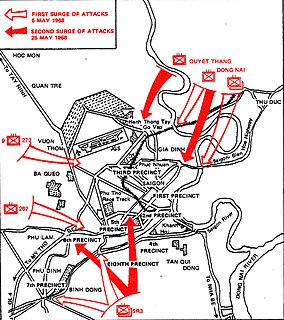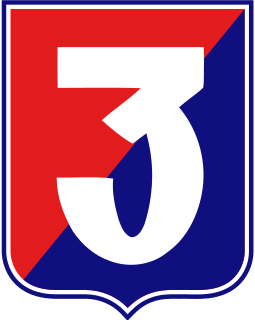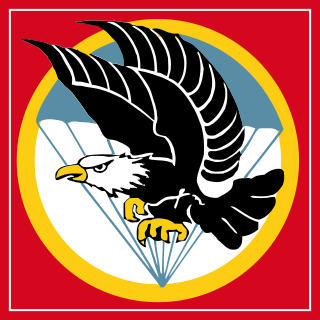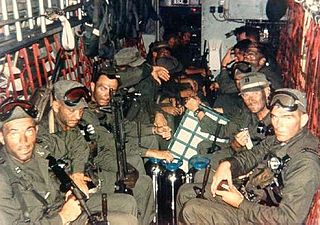
The First Battle of Quảng Trị resulted in the first major victory for the People's Army of Vietnam (PAVN) during the Easter Offensive of 1972. Quảng Trị Province was a major battleground for the opposing forces during the Vietnam War. As South Vietnamese soldiers were gradually replacing their American counterparts, North Vietnam's General Văn Tiến Dũng was preparing to engage three of his divisions in the province. Just months before the battle, the Army of the Republic of Vietnam (ARVN) deployed its newly formed 3rd Division to the areas along the Vietnamese Demilitarized Zone (DMZ) to take over former US bases. North Vietnamese forces deployed against the inexperienced ARVN 3rd Division included the PAVN 304th, 308th and 324B Divisions.

The Republic of Vietnam Marine Division was part of the armed forces of South Vietnam. It was established by Ngo Dinh Diem in 1954 when he was Prime Minister of the State of Vietnam, which became the Republic of Vietnam in 1955. The longest-serving commander was Lieutenant General Le Nguyen Khang. In 1969, the VNMC had a strength of 9,300, 15,000 by 1973, and 20,000 by 1975.

The Vietnamese Rangers, commonly known as the ARVN Rangers, were the light infantry of the Army of the Republic of Vietnam. Trained and assisted by American Special Forces and Ranger advisers, the Vietnamese Rangers infiltrated beyond enemy lines in search and destroy missions. Initially trained as a counter-insurgency light infantry force by removing the fourth company each of the existing infantry battalions, they later expanded into a swing force capable of conventional as well as counter-insurgency operations, and were relied on to retake captured regions. Later during Vietnamization the Civilian Irregular Defense Group program was transferred from MACV and integrated as Border Battalions responsible for manning remote outposts in the Central Highlands.

Phase Two of the Tet Offensive of 1968 was launched by the People's Army of Vietnam (PAVN) and Viet Cong (VC) against targets throughout South Vietnam, including Saigon from 29 April to 30 May 1968. The May Offensive was considered much bloodier than the initial phase of the Tet Offensive. US casualties across South Vietnam were 2,169 killed for the entire month of May, making it the deadliest month of the entire Vietnam War for U.S. forces, while South Vietnamese losses were 2,054 killed. PAVN/VC losses exceeded 24,000 killed and over 2,000 captured. The May Offensive was a costly defeat for the PAVN/VC.

The 1st Division of the Army of the Republic of Vietnam (ARVN)—the army of the nation state of South Vietnam that existed from 1955 to 1975—was part of the I Corps that oversaw the northernmost region of South Vietnam, the centre of Vietnam.

The 3rd Division of the Army of the Republic of Vietnam (ARVN)—the army of the nation state of South Vietnam that existed from 1955 to 1975—was part of the I Corps that oversaw the northernmost region of South Vietnam, the centre of Vietnam.

The Vietnamese Airborne Division was one of the earliest components of the Republic of Vietnam Military Forces. The Vietnamese Airborne Division began as companies organized in 1948, prior to any agreement over armed forces in Vietnam. After the partition of Vietnam, it became a part of the Army of the Republic of Vietnam. This division had its distinct origins in French-trained paratrooper battalions, with predecessor battalions participating in major battles including Dien Bien Phu and retained distinct uniforms and regalia. With the formation of an independent republic, the colonial paratroopers were dissolved, however regalia and aesthetics alongside the nickname "Bawouans" would be retained.

Operation Taylor Common was a search and destroy operation conducted by Task Force Yankee, a task force of the 1st Marine Division supported by the Army of the Republic of Vietnam (ARVN), southwest of Hội An from 6 December 1968 to 8 March 1969.

The inauguration of Richard Nixon in January led to a reevaluation of the U.S. role in the war. U.S. forces peaked at 543,000 in April. U.S. military strategy remained relatively unchanged from the offensive strategy of 1968 until the Battle of Hamburger Hill in May which led to a change a more reactive approach. The U.S. and South Vietnam agreed on a policy of Vietnamization with South Vietnamese forces being expanded and equipped to take over more of the ground combat from the departing Americans which began to withdraw in late June without any reciprocal commitment by the North Vietnamese. The morale of U.S. ground forces began to fray with increasing racial tensions and the first instances of fragging and combat refusal. The antiwar movement in the U.S. continued to grow and public opinion turned increasingly antiwar when the Mỹ Lai massacre was revealed in November.

The United States continued its unilateral withdrawal of forces from South Vietnam notwithstanding the lack of progress at the Paris Peace Talks. The removal of Prince Norodom Sihanouk from power in Cambodia in March and his replacement by General Lon Nol, began the Cambodian Civil War. South Vietnamese and U.S. forces entered Cambodia in late April to attack People's Army of Vietnam (PAVN) and Vietcong (VC) bases and supply lines there which had long been used to support the insurgency in South Vietnam. The expansion of the war revitalized the antiwar movement in the U.S. and led to the Kent State shootings and Jackson State killings in May. While U.S. ground forces withdrew from Cambodia at the end of June and legislation was passed to prevent their reintroduction, the South Vietnamese conducted operations in Cambodia for the rest of the year and the U.S. provided air support and military aid to the Cambodian government. Despite this support the Cambodians lost control of vast areas of the country to the PAVN. Within South Vietnam the second half of the year saw a reduction in large U.S. operations with the focus shifting to pacification and population security and supporting Vietnamization. The PAVN/VC generally reverted to sapper attacks and attacks by fire but they fought hard to defend their base areas and infiltration routes.

At the start of 1971 South Vietnamese troops continued operations against [[NVA) and Vietcong (VC) base areas in eastern Cambodia. The ill-conceived and poorly executed Operation Lam Son 719 against NVA supply lines in eastern Laos showed the weaknesses within the South Vietnamese military command and the limited ability of South Vietnam's armed forces to conduct large-scale combined arms operations. The U.S. continued its unilateral withdrawal from South Vietnam despite the lack of any progress in the Paris Peace Talks and by November U.S. forces had ceased offensive operations. The U.S. withdrawal and antiwar sentiment within the military led to an ongoing decline in morale and discipline within the U.S. forces and growing drug use, particularly of heroin. As U.S. combat units withdrew, security in their former operational areas deteriorated and the PAVN/VC began a series of attacks on ARVN positions in Quảng Trị province and the Central Highlands. In Cambodia the Cambodian government continued to lose ground to the PAVN despite extensive U.S. air support and training and periodic attacks into Cambodia by the ARVN. While the bombing of North Vietnam had ceased in November 1968, U.S. aircraft continued to conduct reconnaissance flights over the North and responded to radar-tracking and antiaircraft fire with "protective reaction" strikes which numbered more that 100 by the year-end and culminated in a five day bombing campaign in late December.
Đông Hà Combat Base is a former U.S. Marine Corps and U.S. Army base northwest of Quảng Trị in central Vietnam. The base was first used by the 4th Marines in late April 1966. In mid-July Đông Hà was used by the Marines as a helicopter base and logistics area. Numerous US marine and army units rotated through the base, and several artillery units were based there.

Cam Lộ Combat Base is a former U.S. Marine Corps, U.S. Army and Army of the Republic of Vietnam (ARVN) base northwest of Quảng Trị in central Vietnam.

Firebase Gio Linh is a former U.S. Marine Corps, U.S. Army and Army of the Republic of Vietnam (ARVN) firebase north of Đông Hà in Quang Tri Province, central Vietnam.
Quảng Trị Combat Base is a former United States Marine Corps, United States Army and Army of the Republic of Vietnam (ARVN) base northwest of Quảng Trị in central Vietnam.
Firebase Fuller is a former U.S. Marine Corps, Army and Army of the Republic of Vietnam (ARVN) firebase in central Vietnam.
Firebase Pedro is a former U.S. Army and Army of the Republic of Vietnam (ARVN) firebase southwest of Quảng Trị in central Vietnam.

Operation Maine Crag was a US Marine Corps, United States Army and Army of the Republic of Vietnam (ARVN) operation that took place in northwest Quảng Trị Province, lasting from 15 March – 2 May 1969.

Operation Napoleon/Saline was a multi-Battalion operation conducted by the United States Marine Corps and the United States Army along the Cửa Việt River south of the DMZ in Quảng Trị Province. The operation ran from 20 January to 9 December 1968.

The Battle of the Mỹ Chánh Line took place from 5 May to 26 June 1972 during the People’s Army of Vietnam (PAVN)'s Easter Offensive of the Vietnam war. South Vietnamese forces, principally the Marine Division, with extensive fire and logistics support from United States forces, succeeded in stopping the PAVN advance northwest of Huế and launched a series of spoiling attacks against PAVN units. The successful defense allowed South Vietnamese forces to build up strength and then establish jumping off positions for their counteroffensive to recapture Quảng Trị Province.
















